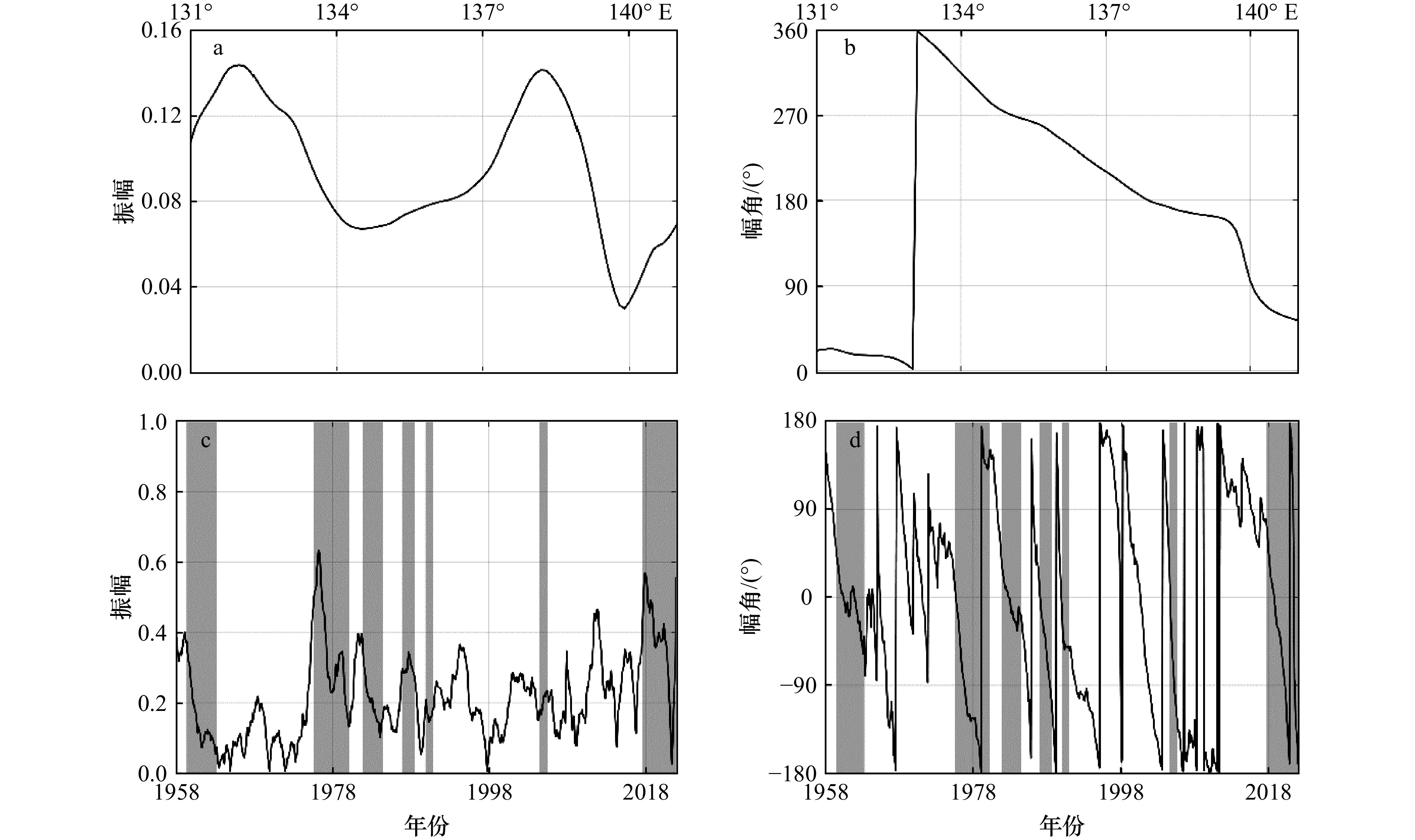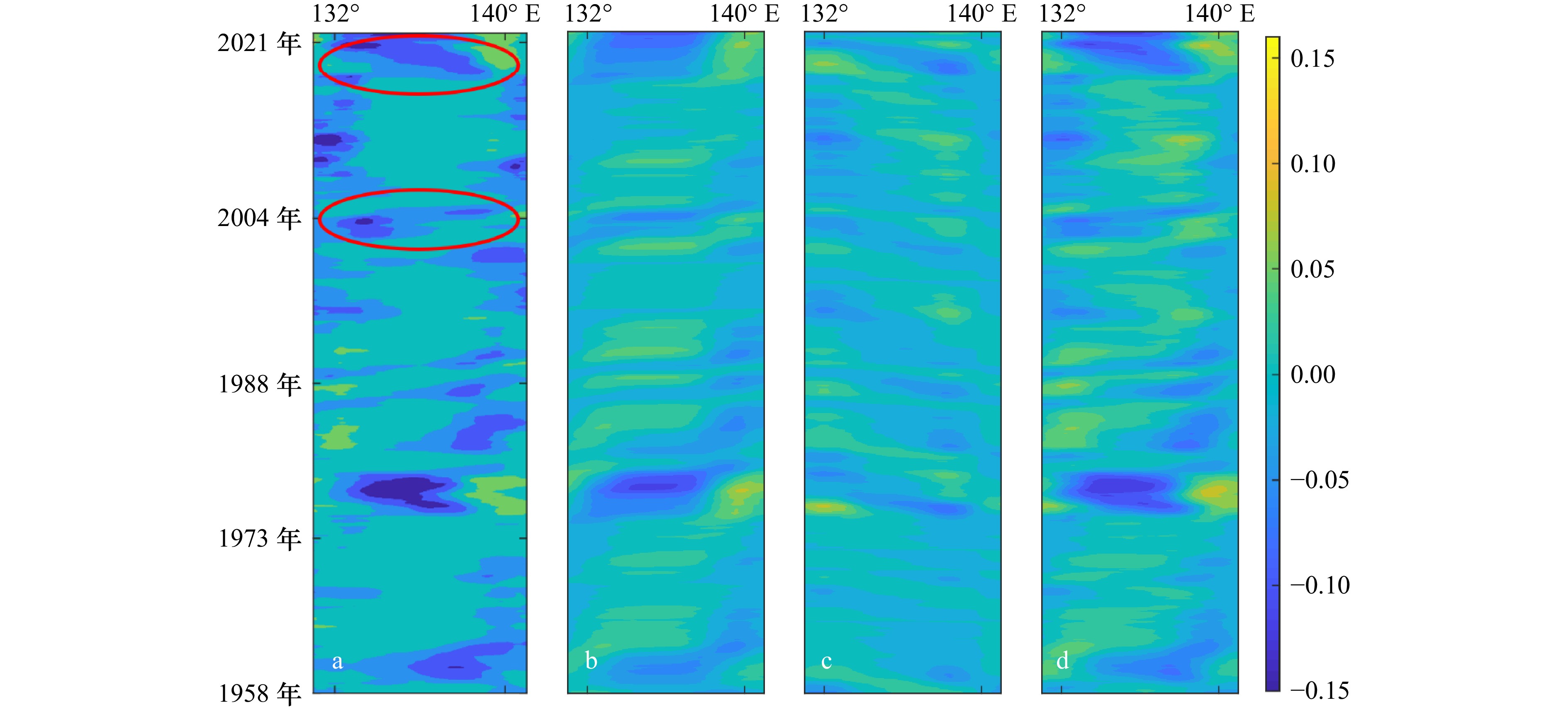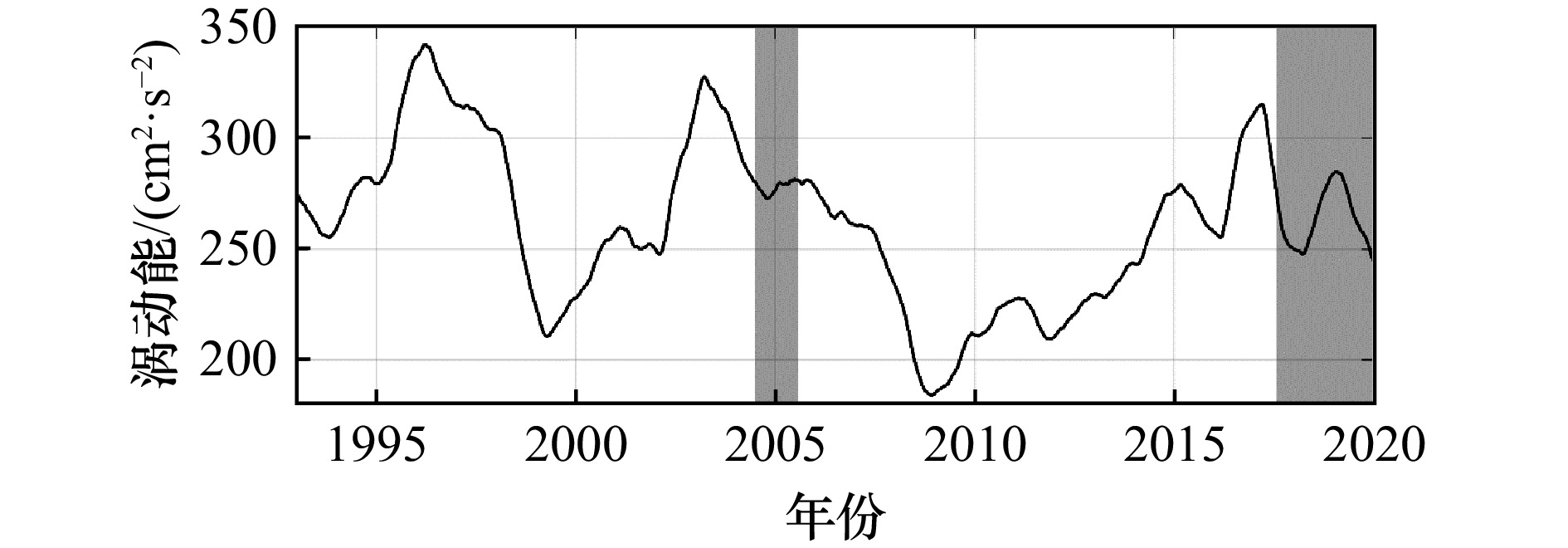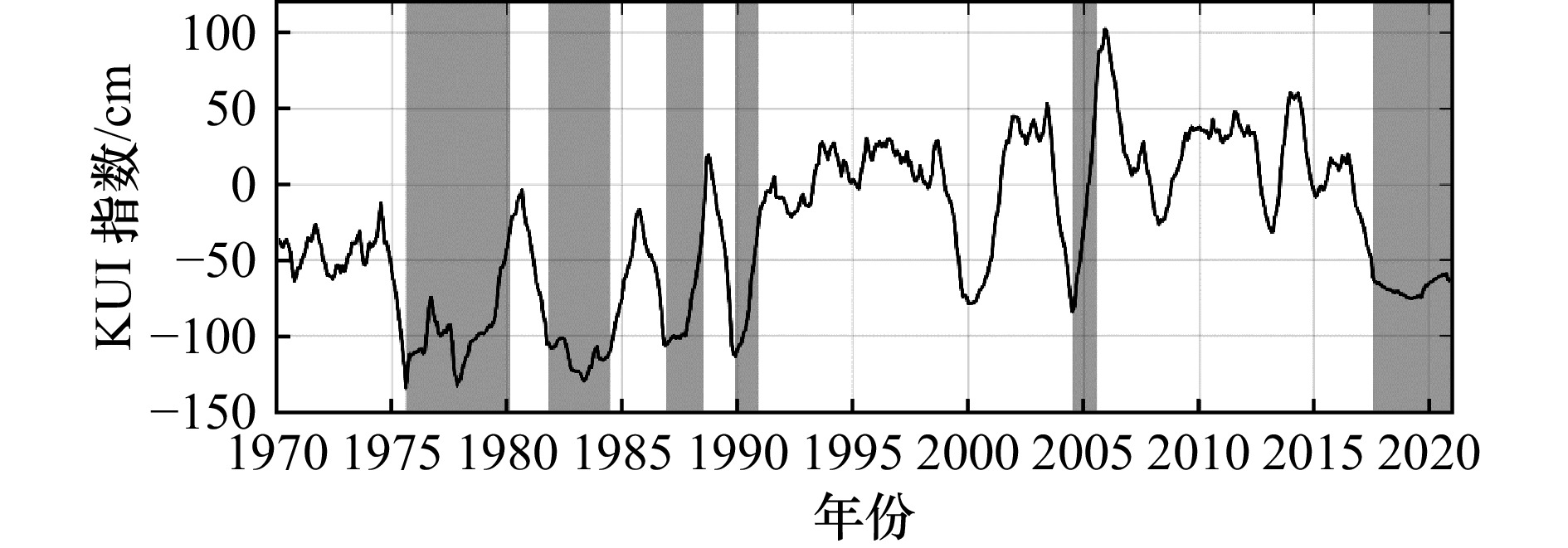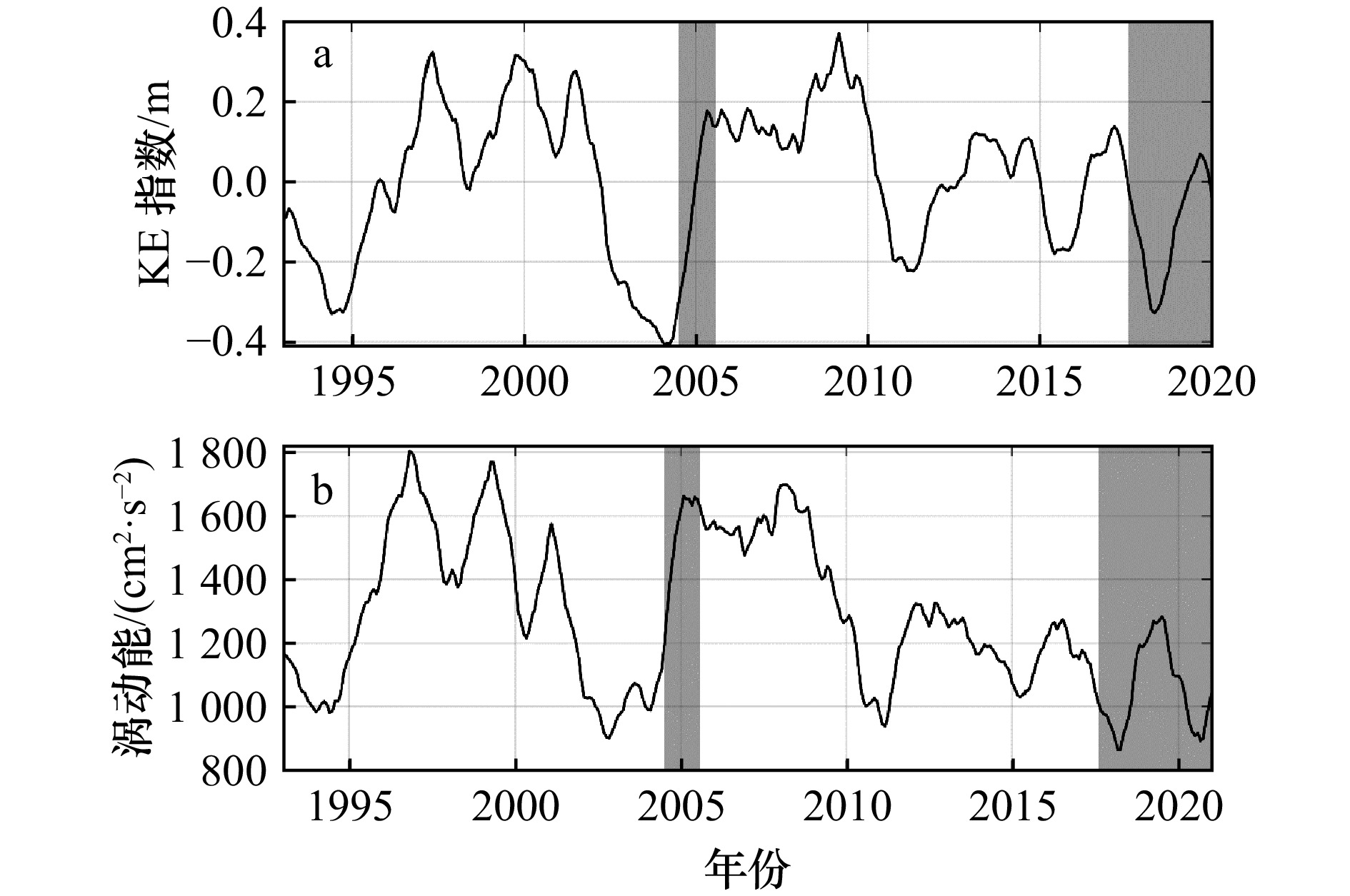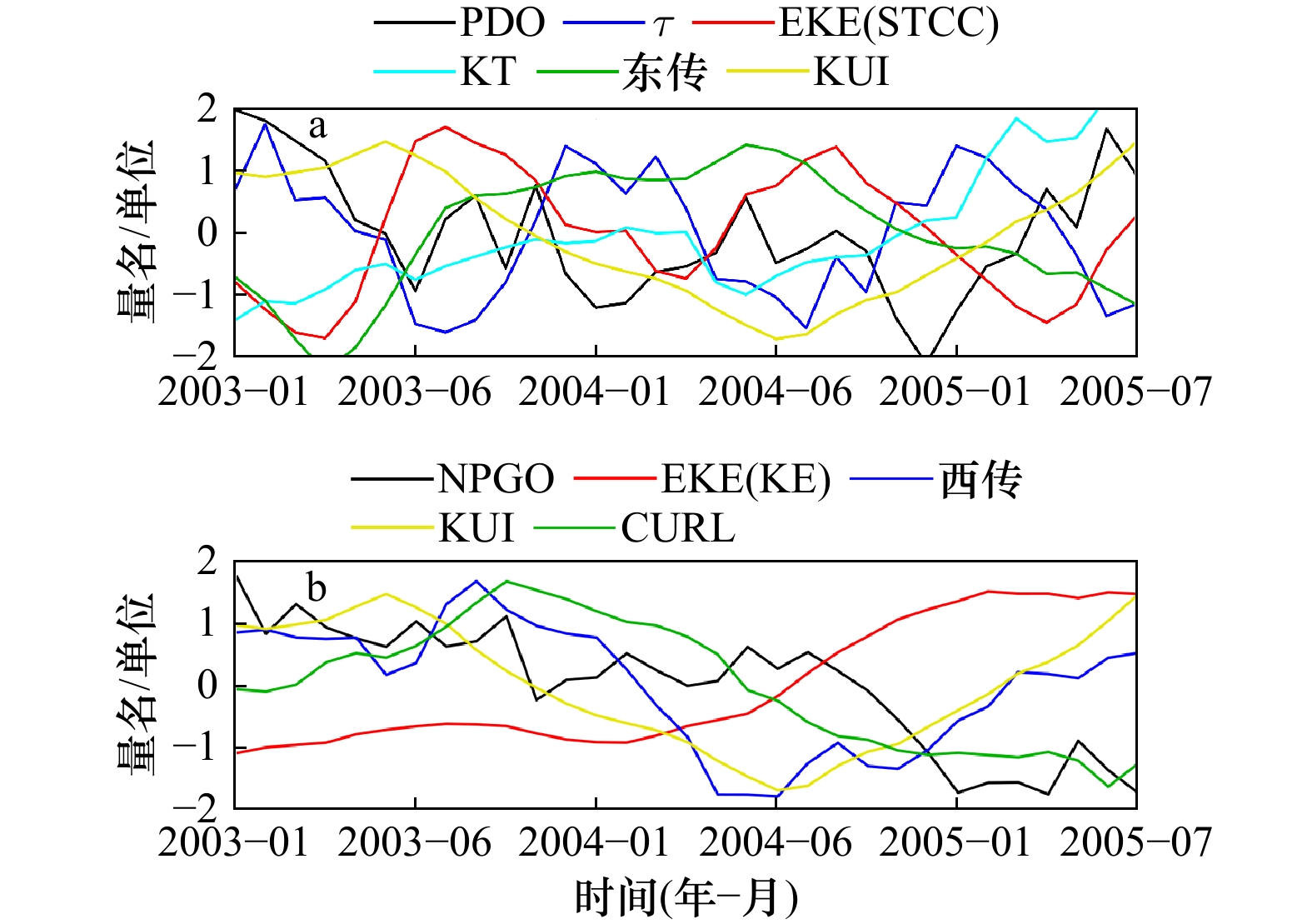Spatiotemporal variation characteristics and causal relationship of the Kuroshio path south of Japan based on complex empirical orthogonal functions
-
摘要: 日本以南黑潮路径变化的相关分析一直是热点之一。过去的研究指出日本以南黑潮路径变化受到多种因素的影响,如上游流量、中尺度涡旋、气候信号等。然而,关于这些影响因素之间的相互因果关系尚不完全清楚。本文基于50a(1958−2007年)中国海洋再分析数据集(CORA)和14a(2008−2021年)卫星高度计资料,获取了日本以南黑潮路径时间序列,并利用复经验正交函数(CEOF)分析方法对其进行时空特征分析。结果表明,经CEOF分析获取的前两个主模态可以描述日本以南黑潮路径时空变化的主要特征,且分别代表与之相关的东传和西传信号。进一步地,基于信息流理论的因果分析结果表明:一方面,太平洋十年涛动(PDO)通过风应力的变化影响副热带逆流(STCC)区域的涡旋活动,从而影响吐噶喇海峡的黑潮输运变化,进而对东传信号产生直接影响,最终影响日本以南海域的黑潮路径变化;另一方面,黑潮延伸体的涡旋活动受到北太平洋涡旋振荡(NPGO)的影响,促使该区域的中尺度涡旋向西移动,进而对西传信号产生直接影响,最终影响日本以南海域的黑潮路径变化。此外,分析结果还表明:日本以南海域的相对涡度和再循环流强度变化是对黑潮路径变化的响应,而非影响黑潮路径变化的因素。Abstract: The analysis of the changes in the path of the Kuroshio south of Japan has always been a hot topic. Previous studies have pointed out that the changes in the Kuroshio path south of Japan are influenced by various factors, such as upstream transport, mesoscale eddies, climate signals etc. However, the causal relationship between these influencing factors is not fully understood. The paper first obtains the time series of the Kuroshio path south of Japan based on the 50 year (1958−2007) China Ocean Reanalysis dataset (CORA) and 14 year (2008−2021) satellite altimeter data, and uses the Complex Empirical Orthogonal Function (CEOF) analysis method to analyze its spatiotemporal characteristics. The results show that the first two main modes obtained by CEOF analysis can describe the main characteristics of the space-time variation of the Kuroshio path in the south of Japan and represent the related eastward and westward signals, respectively. Furthermore, the causal analysis results based on information flow theory indicate that: on the one hand, PDO affects the eddy kinetic energy in the subtropical countercurrent (STCC) region through changes in wind stress, thus affecting the changes of Kuroshio transport in the Tokara Strait, and then has a direct impact on the eastward signal, and finally affects the changes of the Kuroshio path in the southern region of Japan. On the other hand, the eddy kinetic energy of the Kuroshio extension is influenced by the NPGO signal, which affects the westward movement of the mesoscale eddies in the region, thereby directly affecting the westward signal and ultimately affecting the Kuroshio path changes in the region south of Japan. In addition, the experimental results also indicate that the relative vorticity and recirculation gyre strength in the southern region of Japan are responses to the changes in the Kuroshio path, rather than factors affecting the changes in the Kuroshio path.
-
Key words:
- Kuroshio path south of Japan /
- CEOF /
- causality analysis /
- information flow
-
图 1 基于CORA数据绘制的日本以南黑潮3种典型路径
典型大弯曲(蓝色)、离岸非大弯曲(绿色)和近岸非大弯曲(红色),红星分别表示Naze、Aburatsu、Kushimoto和Uragami 4个验潮站
Fig. 1 Three typical paths of Kuroshio south of Japan based on CORA data
Typical Large Meander (blue), offshore Non-Large Meander (green), and nearshore Non-Large Meander (red). The red stars denote tide gauge stations Naze, Aburatsu, Kushimoto and Uragami, respectively
图 2 第一主模态空间分布与时间序列的振幅(无量纲)和幅角
a.空间振幅;b.空间幅角;c.时间振幅;d.时间幅角。灰色阴影区域表示黑潮大弯曲时期
Fig. 2 Amplitude (dimensionless) and angle plots of the spatial distribution and time series of the first principal mode
a. Spatial amplitude; b. spatial angle; c. time amplitude; d. time angle. The gray shaded area represents the period of the Kuroshio Large Meander
图 3 第二主模态空间分布与时间序列的振幅(无量纲)和幅角
a.空间振幅;b.空间幅角;c.时间振幅;d.时间幅角。灰色阴影区域表示黑潮大弯曲时期
Fig. 3 Amplitude (dimensionless) and angle plots of the spatial distribution and time series of the second principal mode
a. Spatial amplitude; b. spatial angle; c. time amplitude; d. time angle. The gray shaded area represents the period of the Kuroshio Large Meander
图 12 日本以南黑潮路径因果关系导向
所有结果均通过90%显著检验。黑色粗实线表示由PDO(NPGO)到日本以南黑潮路径的因果关系链,蓝色细实线表示存在双向因果的反向因果关系链,蓝色虚线表示存在因果关系但仍需进一步验证的过程
Fig. 12 Causal relationship of the Kuroshio path south of Japan
All results passed the 90% significance test. The thick black lines indicate the causal chains from PDO (NPGO) to the path of the Kuroshio south of Japan, the blue thin solid lines indicate reverse causality chains with two-way causation and the blue dashed lines indicate the process where causality exists but requires further verification
表 1 CEOF前3个模态贡献率
Tab. 1 Contribution rate of the first 3 modes of CEOF
模态 模态方差贡献率/% 模态累积方差贡献率/% 1 53.03 53.03 2 23.41 76.44 3 12.81 89.25 表 2 信息流因果分析结果
Tab. 2 Results of causal analysis of information flow
因果 EKE
(STCC)KT 东传 西传 CURL SRG SHEAR KUI KE EKE
(KE)风应力 PDO NPGO EKE(STCC) − − 0.0021 0 0 0.0012 − 0.0253 − 0.0103 0.0001 0.004 − 0.0002 0.0709 0.0171 0.0029 KT 0.0095 − 0.0091 0.00002 0.0006 0.0032 0 0.0134 0.0023 0.0160 − 0.0007 0.0004 0.0001 东传 0 − 0.0075 − − 0.0033 0.0005 0.0004 0 0.0168 − 0.0055 0.0062 0 0 0.0008 西传 0 0.0002 0.0032 − 0 0.0005 0.0003 0.0013 − 0.0052 0.1010 − 0.0001 − 0.0004 0 CURL − 0.0023 0.0208 0.0376 0.0002 − 0.0429 0.0031 0.0352 0.0157 0.0244 − 0.0001 0.0027 0.0004 SRG 0.0283 0.0060 0.0305 0.0025 0.0201 − − 0.0029 0.0233 0.0107 − 0.0004 0.0099 − 0.0004 0.0009 SHEAR 0.0162 0 0 0.0036 0.0217 0.0131 − 0.0003 0.0041 0.0003 0.0046 0.0020 0.0005 KUI 0.0001 − 0.0071 − 0.0092 − 0.0006 0.0018 0.0004 0.0002 − 0.0011 0 0 0 0.0001 KE − 0.0009 0.0025 0.0030 0.0080 0.0008 − 0.0029 − 0.0011 − 0.0011 − 0.0714 0.0001 0.0037 − 0.0026 EKE(KE) 0.0009 − 0.0030 − 0.0007 − 0.0047 − 0.0012 0.0004 − 0.0001 0.0004 − 0.0617 − 0 0.0006 − 0.0027 风应力 -0.055 0.0007 0 0.0001 0.0003 0.0007 0.001 0 0.0003 0.0005 − − 0.0012 0.0003 PDO − 0.0066 0 0.0001 0.0034 0.0028 0.0016 0.0006 0.0004 0.0030 0.0051 0.0011 − 0.0113 NPGO 0.0097 0.0009 − 0.0010 0.0003 − 0.0005 0.0003 0.0002 0 0.0088 0.0061 0.0001 0.0092 − Note:黑色加粗(未加粗)表示通过了(未通过)显著性水平为90%的置信度检验,红色表示重点关注结果。 表 3 超前相关分析
Tab. 3 lead correlation analysis
(a) 东传 PDO-$ \tau $ $ \tau $-EKE EKE-KT KT-东传 东传-KUI 相关性 0.71 −0.82 0.76 −0.86 −0.94 超前/月 1 6 4 2 2 (b) 西传 NPGO-EKE EKE-西传 西传-KUI EKE-CURL 相关性 −0.63 0.92 0.93 −0.85 超前/月 2 2 2 2 -
[1] Takeyoshi Nagai, Hiroaki Saito, Koji Suzuki, et al. Kuroshio Current Physical, Biogeochemical, And Ecosystem Dynamics [M]. American Geophysical Union, Geophysical Monograph 243, 2019. [2] Kawabe M. Sea level variations at the Izu Islands and typical stable paths of the Kuroshio[J]. Journal of the Oceanographical Society of Japan, 1985, 41(5): 307−326. doi: 10.1007/BF02109238 [3] Wu X, Zhao Y, Han G, et al. Temporal-spatial oceanic variation in relation with the three typical Kuroshio paths south of Japan[J]. Acta Oceanologica Sinica, 2022, 41: 15−25. doi: 10.1007/s13131-021-1941-9 [4] 于振娟. 东海黑潮流轴的变化及日本以南黑潮大弯曲同青岛降水量的关系[J]. 海洋科学, 1988, 12(4): 6−11.Yu Zhenjuan. Relationship of variation of axial position of the Kuroshio in the East China Sea and its meanders south of Japan with the precipitation in Qingdao[J]. Marine Sciences, 1988, 12(4): 6−11. [5] Xu H, Tokinaga H, Xie S. Atmospheric effects of the Kuroshio large meander during 2004−05[J]. Journal of Climate, 2010, 23(17): 4704−4715. doi: 10.1175/2010JCLI3267.1 [6] 崔雪森, 伍玉梅, 唐峰华, 等. 日本以南黑潮流量对西北太平洋柔鱼渔场重心影响的滞后性分析[J]. 大连海洋大学学报, 2017, 32(01): 99−104.Cui Xuesen, Wu Yumei, Tang Fenghua, et al. Effect of Kuroshio transport off southern Japan on fishing ground gravity of neon flying squid Ommastrephes bartramii in northwest Pacific Ocean based on time lag analysis [J]. Journal of Dalian Ocean University, 2017, 32(01): 99−104. [7] Lizarbe Barreto, Daniel Andres, Chevarria Saravia, et al. Phytoplankton increase along the Kuroshio due to the large meander [J]. Frontiers in Marine Science, 2021. [8] Hasumi H, Tatebe H, Kawasaki T, et al. Progress of North Pacific modeling over the past decade[J]. Deep-Sea Research II, 2010, 57: 1188−1200. doi: 10.1016/j.dsr2.2009.12.008 [9] Usui N, Wakamatsu T, Tanaka Y, et al. Four-dimensional variational ocean reanalysis: a 30-year high-resolution dataset in the western North Pacific (FORA-WNP30)[J]. Journal of Oceanography, 2017, 73: 205−233. doi: 10.1007/s10872-016-0398-5 [10] Chao S. Bimodality of the Kuroshio[J]. Journal of Physical Oceanography, 1984, 14: 92−103. doi: 10.1175/1520-0485(1984)014<0092:BOTK>2.0.CO;2 [11] Yoon J, Yasuda I. Dynamics of the Kuroshio large meander: Two-layer model[J]. Journal of Physical Oceanography, 1987, 17: 66−81. doi: 10.1175/1520-0485(1987)017<0066:DOTKLM>2.0.CO;2 [12] Kazunori Akitomo, Masao Kurogi. Path transition of the Kuroshio due to mesoscale eddies: A two-layer, wind-driven experiment[J]. Journal of Oceanography, 2001, 57: 735−741. doi: 10.1023/A:1021292627245 [13] Qiu B, Chen S. Revisit of the Occurrence of the Kuroshio large meander south of Japan[J]. Journal of Physical Oceanography, 2021, 51: 3679−3694. doi: 10.1175/JPO-D-21-0167.1 [14] Kobashi F, Hanawa K. Hydrographic features off the southeast coast of Kyushu during the Kuroshio small meanders: A case study for small meanders that occurred in 1994 and 1995 spring[J]. Journal of Oceanography, 2004, 60: 645−661. doi: 10.1007/s10872-004-5758-x [15] Miyazawa Y, Kagimoto T, Guo X, et al. The Kuroshio large meander formation in 2004 analyzed by an eddy-resolving ocean forecast system[J]. Journal of Geophysical Research, 2008, 113: C10015. [16] Usui N, Tsujino H, Nakano H, et al. Long-term variability of the Kuroshio path south of Japan[J]. Journal of Oceanography, 2013, 69: 647−670. doi: 10.1007/s10872-013-0197-1 [17] Ebuchi N, Hanawa K. Trajectory of mesoscale eddies in the Kuroshio recirculation region[J]. Journal of Oceanography, 2001, 57: 471−480. doi: 10.1023/A:1021293822277 [18] Mitsudera H, Waseda T. Anticyclonic eddies and Kuroshio meander formation[J]. Geophysical Research Letters, 2001, 28: 2025−2028. doi: 10.1029/2000GL012668 [19] Ichikawa K. Variation of the Kuroshio in the Tokara strait induced by mesoscale eddies[J]. Journal of Oceanography, 2001, 57: 55−68. doi: 10.1023/A:1011174720390 [20] Usui N, Tsujino H, Nakano H, et al. Formation process of the Kuroshio large meander in 2004[J]. Journal of Geophysical Research, 2008, 113: C08047. [21] Qiu B, Chen S. Variability of the Kuroshio extension jet, recirculation gyre, and mesoscale eddies on decadal time scales[J]. Journal of Physical Oceanography, 2005, 35(11): 2090−2103. doi: 10.1175/JPO2807.1 [22] Sugimoto S, Hanawa K. Relationship between the path of the Kuroshio in the south of Japan and the path of the Kuroshio extension in the east[J]. Journal of Oceanography, 2012, 68: 219−225. doi: 10.1007/s10872-011-0089-1 [23] 吴友婷, 杨洋, 梁湘三. 基于自组织映射的日本南部黑潮与黑潮延伸体的典型时空模态及其因果关系研究[J]. 海洋学报, 2022, 44(09): 38−54.Wu Youting, Yang Yang, Liang Xiangsan. Typical spatiotemporal patterns of the Kuroshio south of Japan and the Kuroshio extension using self organizing maps and their causal relationship[J]. Haiyang Xuebao, 2022, 44(09): 38−54. [24] Ebuchi N, Hanawa K. Influence of mesoscale eddies on variations of the Kuroshio path south of Japan[J]. Journal of Oceanography, 2003, 59: 25−36. doi: 10.1023/A:1022856122033 [25] Miyazawa Y, Guo X, Yamagata T. Roles of mesoscale eddies in the Kuroshio paths[J]. Journal of Physical Oceanography, 2004, 34: 2203−2222. doi: 10.1175/1520-0485(2004)034<2203:ROMEIT>2.0.CO;2 [26] Qiu B, Chen S, Oka E. Why Did the 2017 Kuroshio large meander event become the longest in the past 70 years? [J]. Geophysical Research Letters, 2023. [27] Di Lorenzo E, Schneider N, Cobb K, et al. North Pacific gyre oscillation links ocean climate and ecosystem change[J]. Geophysical Research Letters, 2008, 35: L08607. [28] Ceballos L, Di Lorenzo E, Hoyos C, et al. North Pacific gyre oscillation synchronizes climate fluctuations in the eastern and western boundary systems[J]. Journal of Climate, 2009, 22: 5163−5174. doi: 10.1175/2009JCLI2848.1 [29] Yang Y, Liang X, Qiu B, et al. On the decadal variability of the eddy kinetic energy in the Kuroshio extension[J]. Journal of Physical Oceanography, 2017, 47: 1169−1187. doi: 10.1175/JPO-D-16-0201.1 [30] Wang Q, Tang Y. The interannual variability of eddy kinetic energy in the Kuroshio large meander region and its relationship to the Kuroshio latitudinal position at 140°E [J]. Journal of Geophysical Research: Oceans, 2022, 127(2). [31] Douglass E, Jayne S, Bryan F, et al. Kuroshio pathways in a climatologically forced model[J]. Journal of Oceanography, 2012, 68: 625−639. doi: 10.1007/s10872-012-0123-y [32] Sekine Y, Fujita K. Why does the sea level difference between Kushimoto and Uragami show periods of large meander and non-large meander paths of the Kuroshio south of Japan?[J]. Journal of Oceanography, 1999, 55(1/2): 43−51. [33] Han G, Li W, Zhang X, et al. A new version of regional ocean reanalysis for coastal waters of China and adjacent seas[J]. Advances in Atmospheric Science, 2013(4): 974−982. [34] 武晓博. 日本以南黑潮路径分析与预测研究[D]. 天津: 天津大学, 2020.武晓博. 日本以南黑潮路径分析与预测研究[D]. 天津: 天津大学, 2020. [35] Hurlburt H, Rhodes R, Barron C, et al. A feasibility demonstration of ocean model eddy-resolving nowcast/forecast skill using satellite altimeter data [C]. Naval Research Laboratory, Stennis Space Center, Hancock, 2000. [36] Xu W, Ren H. A CEOF-based method for measuring amplitude and phase properties of the QBO [J]. Climate Dynamics 2023, 61, 923−937. [37] Wu X, Han G, Li W, et al. A hybrid deep learning model for predicting the Kuroshio path south of Japan[J]. Frontiers in Marine Science, 2023, 10: 1112336. doi: 10.3389/fmars.2023.1112336 [38] Liang X. Unraveling the cause-effect relation between time series[J]. Physical Review E, 2014, 90(5): 052150. doi: 10.1103/PhysRevE.90.052150 [39] Liang X. Information flow and causality as rigorous notions ab initio[J]. Physical Review E, 2016, 94(5): 052201. doi: 10.1103/PhysRevE.94.052201 [40] Stips A. On the causal structure between CO2 and global temperature[J]. Scientific Reports, 2016, 6: 21691. doi: 10.1038/srep21691 [41] 邓思捷, 谢玲玲, 朱振坤, 等. 吕宋冷涡的年际变化及影响机制分析[J]. 海洋科学进展, 2022, 40(01): 13−26.Deng Sijie, Xie Lingling, Zhu Zhenkun, et al. Interannual variation of the Luzon cold eddy and its mechanism[J]. Advances in Marine Science, 2022, 40(01): 13−26. [42] 宫湛秋, 孙诚, 李建平, 等. 基于信息流理论的因果分析在辨析大西洋多年代际振荡物理机制中的应用[J]. 大气科学, 2019, 43(5): 1081−1094.Gong Zhanqiu, Sun Cheng, Li Jianping, et al. The application of causality analysis based on the theory of information flow in distinguishing the Atlantic multi-decadal oscillation driving mechanism[J]. Chinese Journal of Atmospheric Sciences, 2019, 43(5): 1081−1094. [43] North G, Bell T, Cahalan R, et al. Sampling errors in the estimation of empirical orthogonal functions[J]. Monthly Weather Review, 1982, 110(7): 699−706. doi: 10.1175/1520-0493(1982)110<0699:SEITEO>2.0.CO;2 [44] Kawabe M. Variations of current path, velocity, and volume transport of the Kuroshio in relation with the large meander[J]. Journal of Physical Oceanography, 1995, 25: 3103−3117. doi: 10.1175/1520-0485(1995)025<3103:VOCPVA>2.0.CO;2 [45] Moriyasu S. On the difference in the monthly sea level between Kushimoto and Uragami, Japan[J]. Journal of the Oceanographical Society of Japan, 1961, 17: 197−200. doi: 10.5928/kaiyou1942.17.197 [46] Qiu B, Chen S, Schneider N, et al. A coupled decadal prediction of the dynamic state of the Kuroshio extension system[J]. Journal of Climate, 2014, 27(4): 1751−1764. doi: 10.1175/JCLI-D-13-00318.1 -




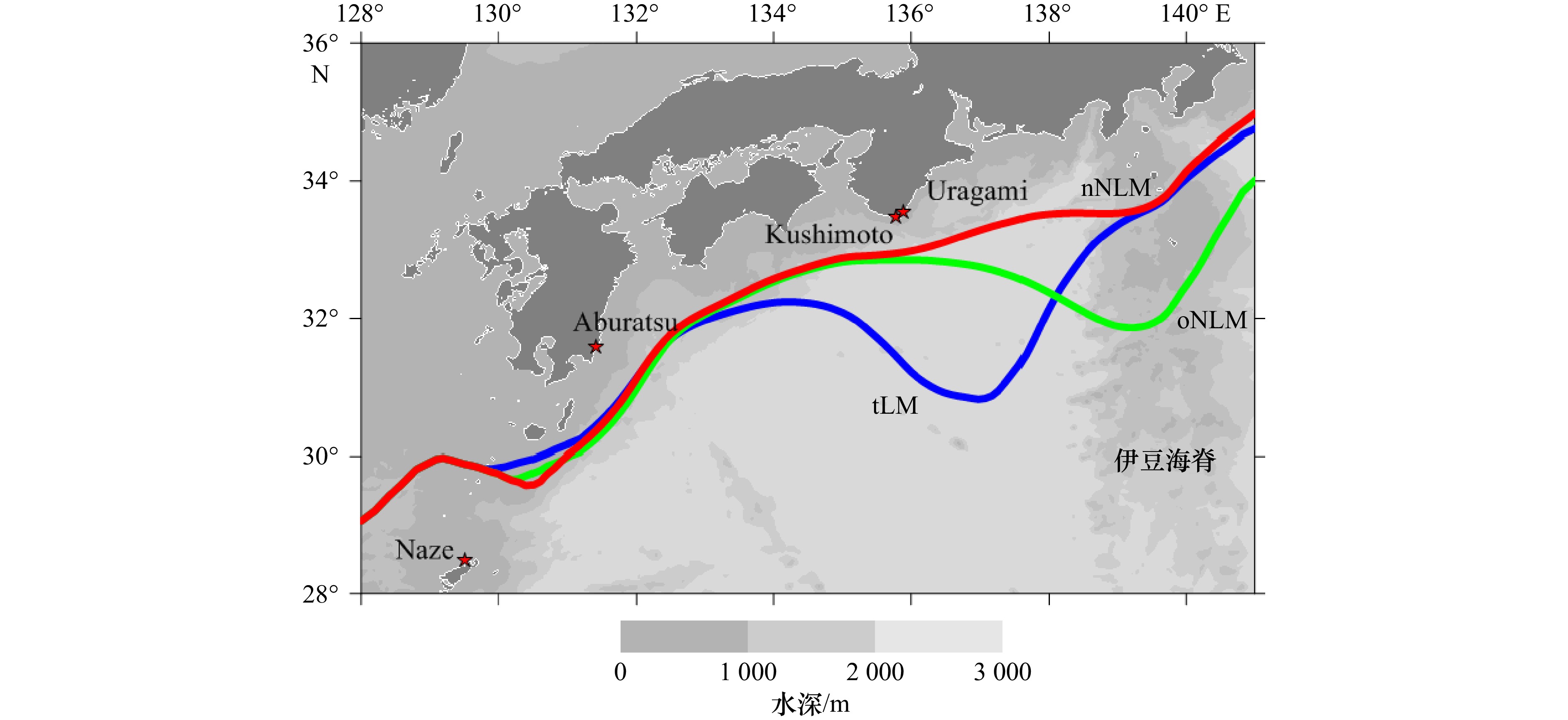
 下载:
下载:

